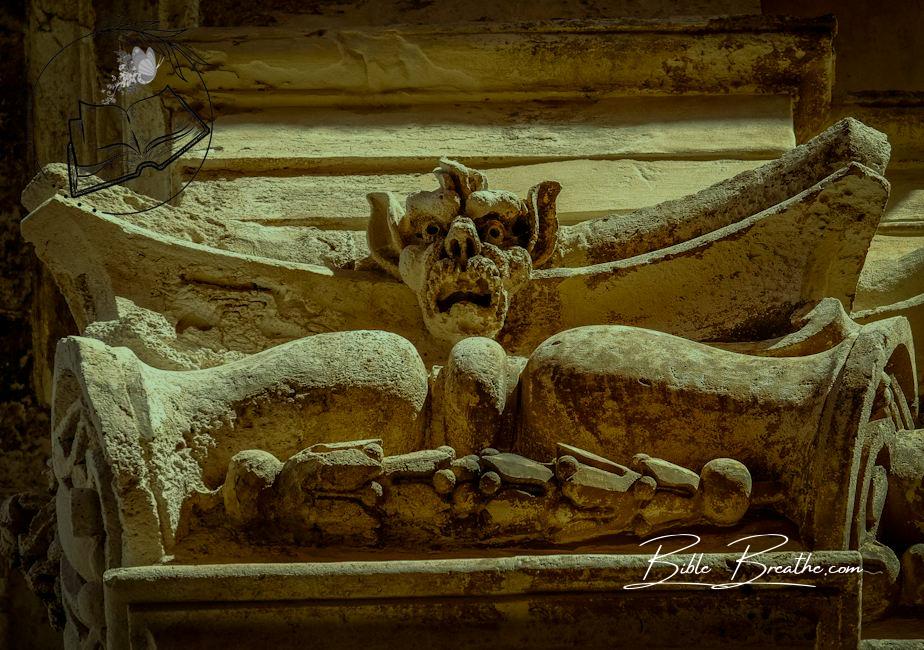Who’s Maze in the Bible?
It’s like flipping through the pages of an ancient mystery novel, and Mazikeen, well, she’s quite the enigma.
You might have met her on the Lucifer TV series, but her story goes way back, deep into the heart of the Bible.
Now, Mazikeen, or Maze as we fondly call her, isn’t your run-of-the-mill demon.
She’s part of a biblical tapestry that threads through the Old Testament, whispers in the Talmud, and even makes a cameo in Dante’s Inferno.
We’re talking demons, archdemons, and a whole cosmic ballet.
In Lucifer, she’s got this wild, complex character.
But let’s take that character and dive into the ancient texts, the scriptures, and myths.
It’s like peeling back layers of a cosmic onion.
So, hang on tight, my friends, as we embark on a journey to discover the Bible’s Maze, the roots, and the depths of her story.
It’s a revelation that’ll leave you in awe.
🌟
Key Takeaways
- Composite Character Inspiration: Mazikeen, a character from the “Lucifer” series, is not a direct biblical figure. Instead, she is a composite character with inspirations drawn from various religious and mythological sources, including Judaism, Christianity, and ancient Mesopotamian beliefs.
- Religious Significance: Although Mazikeen doesn’t have a direct biblical counterpart, her name and certain characteristics have religious significance. Her name, for instance, may be inspired by “Mazzikim,” malevolent spirits in Jewish folklore. Her association with the Devil, as depicted in the series, aligns with the biblical portrayal of Lucifer, the fallen angel.
- Creative Fusion of Fiction and Religion: The “Lucifer” series creatively blends elements of fiction with religious and mythological themes. It explores complex moral and philosophical questions through its characters, including the character of Mazikeen. While the series takes artistic liberties, it engages with religious and supernatural concepts in a thought-provoking manner.
In summary, Mazikeen is a character from the “Lucifer” series who draws inspiration from various religious and mythological sources.
While she doesn’t have a direct biblical counterpart, her name and characteristics hold religious significance within the context of the series, which creatively explores themes related to religion and the supernatural.
Unveiling the Enigma: Maze in Modern Storytelling

Photo modified by BibleBreathe.com. Original photo by Francesco Ungaro on Pexels
Ever been curious about this enigmatic figure named Maze, and whether she graces the pages of the Bible?
Picture this: Maze, a character shrouded in intrigue, stepping into the spotlight not in the Bible, but in modern tales.
The Quest to Uncover Maze
So, you’re likely wondering, “Who is Maze in the Bible?” Well, truth be told, you won’t uncover her within the sacred pages.
Maze, a shortened form of Mazikeen, emerges from contemporary narratives, particularly the TV series “Lucifer.”
Mazikeen’s Role in the Lucifer Series
In the realm of “Lucifer,” Maze takes center stage as a demon with a complex, captivating backstory.
While she’s not a biblical luminary, her influence extends into the present storytelling, notably within the TV series “Lucifer.”
“I’m not a monster; I’m just ahead of the curve.” – The Joker
Maze stands distinct, embodying unique powers and abilities that elevate her in a world teeming with celestial and otherworldly beings.
She’s more than just a demon; she’s Lucifer Morningstar’s trusted confidant, her origins entwined with Lilith, a figure from myth and religious tales.
The Arsenal of Powers and Abilities
Maze wields a potent arsenal of physical prowess, showcasing unmatched combat skills and agility.
Her strength sets her apart, and her unique ability to extract information from anyone makes her invaluable to Lucifer in his detective endeavors.
While Maze doesn’t hail from the biblical accounts, her portrayal in “Lucifer” draws inspiration from an array of sources, including religious texts like the Talmud and the Old Testament, along with literary classics like Dante’s Inferno.
This infusion of influences crafts her character into a captivating addition to the modern entertainment landscape.
So, the next time you encounter the name Maze in the context of “Lucifer,” remember that she’s a character woven from the fabric of mythology, religious texts, and creative storytelling, adding a devilish allure to the world of contemporary tales.
Unveiling the Enigma of Maze in the Bible

Photo modified by BibleBreathe.com. Original photo by Mikhail Nilov on Pexels
So, you’re wondering who Maze is in the Bible, huh?
Well, let’s dive into this intriguing topic together.
Maze’s Biblical and Mythological Roots
Now, Maze, also known as Mazikeen, is a captivating character, but here’s the scoop – she doesn’t actually have a direct counterpart in the Bible.
She’s like a character in a modern-day novel, unique and captivating.
But, her name has some fascinating connections that we need to explore.
The Mysterious Term ‘Mazzikin’
To unravel this, let’s dig into the Hebrew language.
The term ‘Mazzikin’ comes from Hebrew, and it means ‘those who harm.’ Think of it as a way to describe troublemakers, a bit like those mischievous kids who used to disrupt class back in the day.
Talmud’s Take on Mazzikin
Now, here’s where it gets even more interesting.
The Talmud, a collection of Jewish writings, talks about Mazzikin as invisible demons.
Imagine them as unseen troublemakers, always up to no good.
They’re a bit like those mysterious forces you can’t quite see, but you can definitely feel their presence.
Maze’s Company in the Bible Universe
Let’s broaden our view a bit here.
While Maze herself might not directly appear in the Bible, the Bible is packed with a cast of intriguing characters and entities.
- Lucifer – The fallen angel who rebelled against God.
- Demon – Malevolent supernatural beings often depicted as agents of evil.
- Lilith – A figure sometimes associated with dark forces and rebellion.
- Archdemon – A high-ranking demon, often portrayed as a formidable adversary.
- Hell – A place of punishment and torment in religious texts.
These figures and concepts often make appearances in various religious texts, including the Old Testament and the New Testament.
Maze Beyond the Bible
Maze’s story also extends beyond religious texts.
You might find her in literary works like Dante’s Inferno, where she could be seen as a symbol of the complex nature of sin and punishment.
So, while Maze herself isn’t directly in the Bible, her character draws from a rich tapestry of mythological and religious elements.
It’s like she’s a puzzle piece in a much larger picture, adding depth and intrigue to the world of biblical and mythological storytelling.
“For we wrestle not against flesh and blood, but against principalities, against powers, against the rulers of the darkness of this world, against spiritual wickedness in high places.” – Ephesians 6:12 (KJV)
Isn’t it fascinating how stories and characters intertwine across time and cultures?
Maze may not have a biblical chapter to call home, but her roots run deep in the realms of ancient tales and beliefs.
The Tale of Lilith and Mazikeen: Unraveling the Mystery

Photo modified by BibleBreathe.com. Original photo by Mikhail Nilov on Pexels
Have you ever wondered about the intriguing character known as Mazikeen in popular culture, particularly in the TV series “Lucifer”?
Well, to get to the bottom of her story, we need to take a journey back to the beginnings of another mysterious figure, Lilith, whose story might just hold the key to understanding Mazikeen.
Lilith: An Enigma in Genesis
Lilith isn’t your run-of-the-mill biblical character; she’s a bit of an enigma.
You see, her name doesn’t pop up in the usual verses of the Old Testament.
Instead, her story is shrouded in mystery, making her a subject of fascination for scholars and storytellers alike.
Now, some believe Lilith’s tale has roots in the book of Genesis, specifically Genesis 1:27, which says, “So God created man in his own image, in the image of God created he him; male and female created he them.
This passage hints at the creation of both male and female simultaneously, sparking discussions about an original Eve before the more familiar Eve created from Adam‘s rib.
Lilith’s Transformation: From Woman to Demon
Lilith’s journey takes an intriguing twist as she transforms into a demon, aligning her story with that of Mazikeen, especially in contemporary interpretations like the TV series “Lucifer.”
And the devil that deceived them was cast into the lake of fire and brimstone, where the beast and the false prophet are, and shall be tormented day and night for ever and ever.” – Revelation 20:10 (KJV)
In the show, Lilith’s path darkens as she embraces her demonic nature.
This transformation symbolizes the complex struggles that individuals face in their quest for self-discovery and acceptance.
Mazikeen: The Echo of Lilith
Mazikeen, affectionately known as Maze, emerges as a demon in “Lucifer” with a lineage that traces back to Lilith.
While she might not be a direct biblical character, Maze’s existence draws inspiration from Lilith’s captivating narrative and her evolution into a demon.
In this modern twist on ancient tales, Maze embodies the essence of Lilith’s journey, making her a character worth exploring for anyone intrigued by the blending of mythology, religious texts, and creative storytelling.
So, though you won’t find Maze explicitly mentioned in the Bible, her origins are intricately intertwined with the enigmatic story of Lilith, offering a fresh perspective on timeless themes of transformation and self-discovery.
Unveiling the World of Demons in Religious Texts

Photo modified by BibleBreathe.com. Original photo by Mikhail Nilov on Pexels
So, you’re curious to explore the realm of demons in religious texts, including the enigmatic character Maze.
Well, grab your seat and get ready for an eye-opening journey.
Demons in the Old Testament
In the Old Testament, demons may not be the main stars, but they certainly make intriguing cameos.
Forget about the Hollywood-style demons with pitchforks and horns; these are more like shadowy figures lurking in the background.
The Old Testament often mentions malevolent spirits and forces that stand in opposition to the divine plan.
Think of them as the antagonists in a cosmic drama, trying to disrupt the grand narrative.
Unmasking Demons in the New Testament
Now, when we enter the New Testament, demons step into the spotlight.
They become more vivid, with distinct characteristics.
You’ll encounter descriptions of demon possession, exorcisms, and the epic battle between good and evil.
It’s like a gripping supernatural thriller, with demons as the formidable adversaries challenging faith and goodness.
Dante’s Inferno: A Fiery Tale of Demons
Ah, Dante’s Inferno – a literary masterpiece that takes you on a journey through the circles of Hell.
In this epic work, demons aren’t just adversaries; they are the architects of torment.
Each demon embodies a specific sin or vice, delivering its unique punishment.
Imagine it as a nightmarish theme park, where demons play the roles of sadistic hosts.
Now, as for Maze, she doesn’t directly appear in these religious texts, but her character draws inspiration from the rich tapestry of demonology.
She’s a modern reinterpretation of humanity’s age-old fascination with the supernatural and the eternal struggle between good and evil.
“And no marvel; for Satan himself is transformed into an angel of light.” – 2 Corinthians 11:14 (KJV)
In the grand tapestry of religious texts, demons like Maze are like threads, weaving a complex narrative of temptation, struggle, and redemption.
They remind us of the enduring conflict between darkness and light, a theme that resonates through the ages.
So, while Maze may not have her own biblical chapter, her story is a testament to the timeless allure of the supernatural in human storytelling.
Unveiling the Maze in the Bible

Photo modified by BibleBreathe.com. Original photo by Mikhail Nilov on Pexels
Ever wondered if there’s a connection between the name “Maze” and the Bible?
Well, let’s take a journey into the intriguing world of biblical references.
Maze in the Scriptures?
If you’ve delved into the pages of the Bible, you might be wondering if there’s a mention of someone named Maze or Mazikeen.
The truth is, the Bible doesn’t feature a character with that name.
But don’t let that discourage you; there are countless captivating characters in the Bible, each with their own unique stories and lessons.
For I know the thoughts that I think toward you, saith the Lord, thoughts of peace, and not of evil, to give you an expected end.” – Jeremiah 29:11 (KJV)
Finding Inspiration in Biblical Characters
While Maze from “Lucifer” may not have a direct biblical counterpart, there’s a wealth of inspiration to be found in the Bible’s rich tapestry of characters.
Take David, for example, a shepherd who became a king and a man after God’s own heart.
His journey is a testament to the transformative power of faith and resilience.
Or consider Joseph, who endured trials and tribulations but ultimately rose to a position of great influence and forgiveness.
His story reminds us of the importance of staying true to our values even in the face of adversity.
Lessons from the Maze of Life
In our own lives, we often navigate mazes of challenges, doubts, and self-discovery.
While Maze from “Lucifer” may be a fictional character, her journey can still resonate with us.
Just like Maze, we too seek answers to questions of identity, purpose, and redemption.
So, while the name Maze may not be found in the Bible, the lessons and inspiration we draw from biblical characters can guide us on our own journeys of self-discovery and transformation.
In the end, it’s not about finding a specific character in the Bible but about discovering the timeless wisdom and guidance it offers to all who seek it.
Frequently Asked Questions (FAQs) About Who Is Maze In The Bible
Is Mazikeen directly mentioned in the Bible?
No, Mazikeen is not directly mentioned in the Bible.
She is a fictional character from modern literature and not a biblical figure.
How is Mazikeen related to Lilith?
Mazikeen is not a biblical figure; she is a character from the TV series ‘Lucifer,’ which is a work of fiction and not part of biblical canon.
Lilith is a figure found in certain Jewish folklore and later adaptations, but her connection to Mazikeen is primarily a creative invention in the show.
Are there other characters in the Lucifer series with biblical origins?
Yes, several characters in the Lucifer series are inspired by biblical figures.
Characters like Amenadiel, Mazikeen, and Lucifer Morningstar himself draw influence from angelic and demonic beings depicted in religious texts, adapting their roles and traits for the show’s narrative.
{
“@context”: “https://schema.org”,
“@type”: “FAQPage”,
“mainEntity”: [
{
“@type”: “Question”,
“name”: “Is Mazikeen directly mentioned in the Bible?”,
“acceptedAnswer”: {
“@type”: “Answer”,
“text”: “No, Mazikeen is not directly mentioned in the Bible. She is a fictional character from modern literature and not a biblical figure.”
}
},
{
“@type”: “Question”,
“name”: “How is Mazikeen related to Lilith?”,
“acceptedAnswer”: {
“@type”: “Answer”,
“text”: “Mazikeen is not a biblical figure; she is a character from the TV series ‘Lucifer,’ which is a work of fiction and not part of biblical canon. Lilith is a figure found in certain Jewish folklore and later adaptations, but her connection to Mazikeen is primarily a creative invention in the show.”
}
},
{
“@type”: “Question”,
“name”: “Are there other characters in the Lucifer series with biblical origins?”,
“acceptedAnswer”: {
“@type”: “Answer”,
“text”: “Yes, several characters in the Lucifer series are inspired by biblical figures. Characters like Amenadiel, Mazikeen, and Lucifer Morningstar himself draw influence from angelic and demonic beings depicted in religious texts, adapting their roles and traits for the show’s narrative.”
}
}
]
}
Matt Turner
I’m Matt, and I love breaking down Bible verses in a way that’s easy to understand and apply to everyday life. My goal is to help you connect with God’s Word and find practical ways to live it out. Whether you’re new to the Bible or just looking for some fresh insights, I’m here to walk with you and share what I’ve learned along the way.

